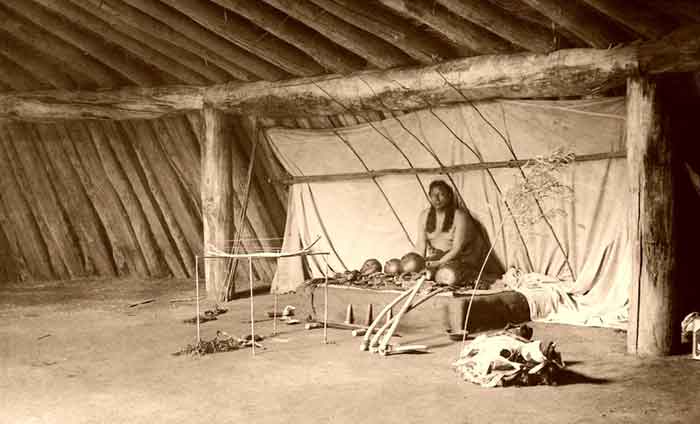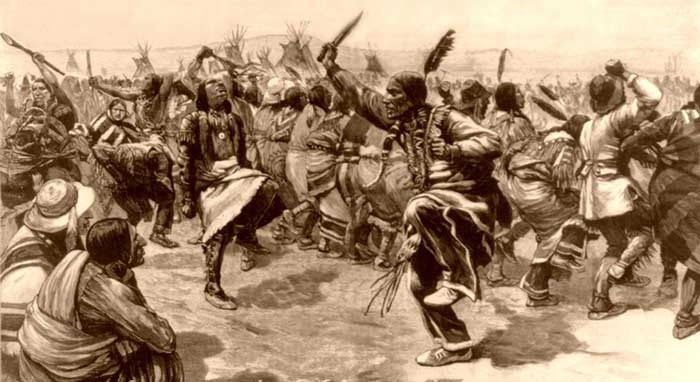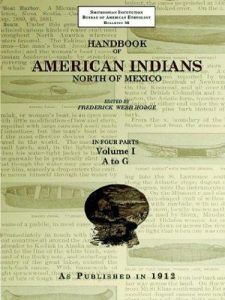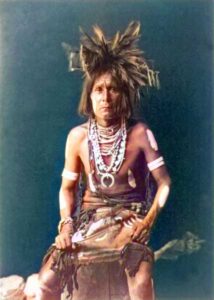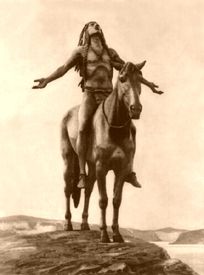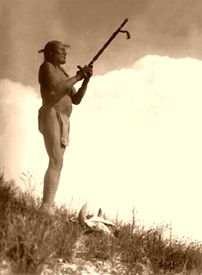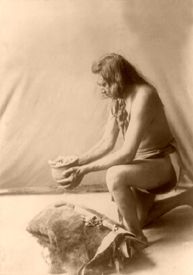Though Native Americans‘ spirituality, ceremonies, and rituals were often referred to as “religion,” most did not consider it in the way Christians do. However, it was labeled as such by American writers, soldiers, and settlers, perhaps because they didn’t know how to describe the rituals and ceremonies otherwise. The Native Americans themselves believed that their rituals and practices formed an integral and seamless part of their very being. Like other aboriginal peoples around the world, their beliefs were heavily influenced by their methods of acquiring food – from hunting to agriculture. They also embraced ceremonies and rituals that provided power to conquer the difficulties of life, as well as events and milestones such as puberty, marriage, and death. Over the years, practices and ceremonies changed with the tribes‘ needs.
From tribe to tribe, these rituals exhibited great diversity, mainly due to the relative isolation of cultures spread across the North American continent for thousands of years. However, most “religions” were closely connected to the land and the supernatural, addressing an ever-present invisible universal force.
In 1920, Clark Wissler, in his book North American Indians Of The Plains, briefly described some of the religious concepts of the Plains tribes. (Excerpt is edited and not verbatim.)
“To most of us, the mention of religion brings to mind notions of God, a supreme overruler, and a decidedly personal being. Nothing just like this is found among the Indians. Yet, they seem to have formulated rather complex and abstract notions of a controlling power or series of powers pervading the universe. Thus, the Dakota use a term, Wakan Tanka, which seems to mean the greatest sacred ones. The term has often been rendered as the “Great Mystery,” but that is not quite correct. It is true that anything strange and mysterious is pronounced Wakan, or as having attributes analogous to Wakan Tanka, but this seems to mean supernatural.
In fact, the Dakota do recognize a hierarchy in which the Sun stands first, or is one of the Wakan Tanka. Of almost equal rank are the Sky, the Earth, and the Rock. Next in order is another group of four — the Moon (female), Winged-One, Wind, and the “Mediator” (female). Then come inferior beings, the buffalo, bear, the four winds, and the whirlwind; then come four classes or groups of beings, and so on in almost bewildering complexity. So far as we know, no other Plains tribe has worked out quite so complex a conception. The Omaha Wakonda is, in a way, like the Dakota Wakan Tanka. The Pawnee recognized a dominating power spoken of as Tirawa, or” father,” under whom were the heavenly bodies, the winds, the thunder, lightning, and rain; but, they also recognized a sacred quality, or presence, in the phenomena of the world, spoken of as Kawaharu, a term whose meaning closely parallels the Dakota Wakan. The Blackfeet resolved the phenomena of the universe into “powers,” the greatest and most universal of which is Natosiwa or sun power. The sun was, in a way, a personal god, with the moon as his wife and the morning star as his son. Unfortunately, we lack data for most tribes, which is a point particularly difficult to investigate. One thing, however, is suggested. There is a tendency here to conceive of some all-pervading force or element in the universe that emanates from an indefinite source to which a special name is given, which in turn, becomes an attribute applicable to every manifestation of this conceivably divine element. Probably nowhere, not even among the Dakota, is there a clear-cut formulation of a definite god-like being with definite powers and functions.
A Supernatural Helper
It is, however, much easier to gather reliable data on religious activities or the functioning of these beliefs in everyday life. In the Plains, as well as in other parts of the continent, the ideal is for all males to establish a direct relationship with a divine element or power. The idea is that if one follows the proper formula, the power will appear in some human or animal form and will form a compact with the young man for his good fortune during life.
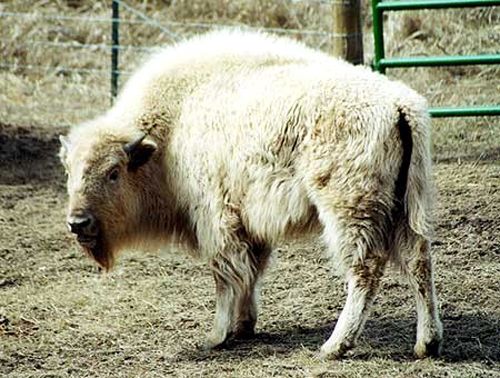
White Buffalo.
Generally, the youth will put himself in the hands of a priest or shaman, who instructs him and requires him to fast and pray alone in some secluded spot until a vision or dream is obtained. In the Plains, such an experience results in the conferring of one or more songs, the laying on of certain curious formal taboos, and the designation of some object, such as a feather, skin, or shell, to be carried and used as a charm or medicine bundle.
This practice has been reported for the Sarsi, Plains-Cree, Blackfeet, Gros Ventre, Crow, Hidatsa, Mandan, Dakota Sioux, Assiniboine, Omaha, Arapaho, Cheyenne, Kiowa, and Pawnee. It is probably universal except perhaps among the Ute, Shoshone, and Nez Perce. We also know that it is frequent among the Woodland Cree, Menomini, and Ojibway. Aside from hunger and thirst, there was no self-torture except among the Dakota and possibly a few others of Sioux stock. With these, it was the rule for all desiring to become shamans, or those in close rapport with the divine element, to thrust skewers through the skin and tie themselves up as in the Sun Dance.
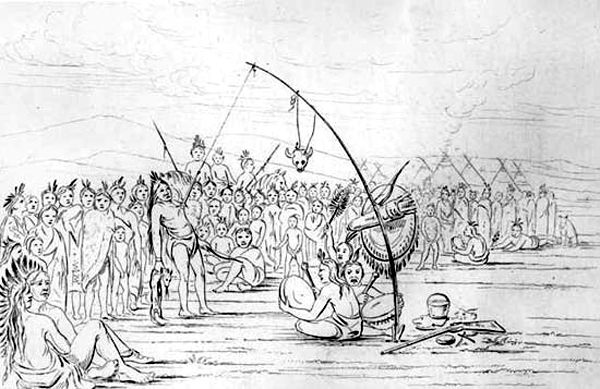
Sun Dance ceremony by George Catlin.
When a Blackfeet, a Dakota, or an Omaha went out to fast and pray for a revelation, he called upon all the recognized mythical creatures, the heavenly bodies, and all in the earth and in the waters, which are consistent with the tribes’ conceptions of power. If this divine element spoke through a hawk, for example, the young man would then look upon that bird as his Wakonda. He would then keep in a bundle the skin or feathers of a hawk that the divine presence might ever be at hand. This is why the warriors of the Plains carried such charms into battle and looked to them for aid.
Banning of Religious Rights:
The arrival of European settlers marked a significant change in Native American culture. Some of the first Europeans that the Indians would meet were often missionaries who looked upon Native American Spirituality practices as worthless superstitions inspired by the Christian devil. These early missionaries were determined to convert the Native Americans to Christianity.
As more and more Europeans flooded North America, the United States and Canadian governments instituted policies to force natives onto reservations and to encourage them to become assimilated into the majority culture.
Beginning in 1882, the Federal Government began to work towards banning Native American religious rights, which impacted their spiritual traditions.
At that time, U.S. Interior Secretary Henry M. Teller ordered an end to all “heathenish dances and ceremonies” on reservations due to their “great hindrance to civilization.” This was further supported the following year by Hiram Price, Commissioner of Indian Affairs, when his 1883 report stated:
“…there is no good reason why an Indian should be permitted to indulge in practices which are alike repugnant to common decency and morality; and the preservation of good order on the reservations demands that some active measures should be taken to discourage and, if possible, put a stop to the demoralizing influence of heathenish rites.”
These attempts to suppress the traditions of Native Americans eventually led to the Massacre at Wounded Knee on December 29, 1890, when the government attempted to stop the practice of the “Ghost Dance,” a far-reaching movement that prophesied a peaceful end to white American expansion and preached goals of clean living, an honest life, and cross-cultural cooperation by Native Americans.
When the Seventh U.S. Cavalry was sent into the Lakota Sioux’s Pine Ridge and Rosebud Reservations to stop the dance and arrest the participants, approximately 150 Native American men, women, and children were killed. Though charges of killing innocents were brought against members of the Seventh Calvary, all were exonerated. Just two years later, further measures were taken to suppress native religions when Commissioner of Indian Affairs Thomas J. Morgan ordered penalties of up to six months in prison for those who repeatedly participated in religious dances or acted as medicine men. However, these new laws were almost impossible to enforce, and the Native Americans continued their customs.
Though some traditions were lost along the way, many others survived despite the ban, and various tribes continue to follow many spiritual traditions. Some Native Americans have been devout Christians for generations, and their practices today combine their traditional customs with Christian elements. Other tribes, particularly in the Southwest, have retained their aboriginal traditions, which are mostly intact.
Amazingly, the ban against Native American spiritual rituals continued to be in place until the 1978 passage of the American Indian Religious Freedom Act. Today, many tribes continue to guard the knowledge of their medicine people and will not discuss the topic with non-Indians. Some believe that sharing healing knowledge will weaken the spiritual power of “the medicine.”
****
In 1906, the Bureau of Ethnology published an extensive four-volume work entitled the Handbook of American Indians North of Mexico. This work was compiled by some of the best-known Indian researchers of the time, from 1873 to 1905, and edited by Frederick W. Hodge, an anthropologist, archaeologist, and historian who worked for the bureau.
In this work, Native American Religion is described, offering a view of perceptions from a century ago. Below is an edited excerpt from this historical publication.
Indian Religion From the Handbook of American Indians North of Mexico, by Frederick W. Hodge, 1906
For a brief description of the religion of the American Indians, we define religion as a set of concepts and practices that spring from the relation of the individual to the outer world. The scope of religious concepts depends, to a certain extent, on the knowledge of the laws of nature, and since the natural and the supernatural, as conceived in the mind of Native Americans, do not coincide with our view of this subject, there are marked differences in the scope of religion.
For instance, the causal relations determining the movements of the stars are now recognized by civilized man. Still, at an earlier time, it was believed that the positions of the stars, mysteriously influenced, determined the fates of man, and that his will could control their movements. Among tribes that held to the latter opinion, views relating to the heavenly bodies would form part of the religion of the people, while among those peoples to which the causal relations determining the motions of the stars are known, these motions are no longer subject to religious interpretations.
Among American terms, the word “Manito” has been most frequently used to express this idea. The degree to which the magic power of nature is individualized differs considerably among various tribes. Although the belief in the powers of inanimate objects is common, we find that, on the whole, animals, particularly the larger ones, are most frequently considered as possessed of such magic power.
The whole concept of the world, or mythology of each tribe, enters to a very great extent into their religious concepts and activities. Mythologies are highly specialized across different parts of North America. Although many myths are common to many American tribes, the general view of the world appears quite distinct across the continent. Taking the continent of America as a whole into consideration, we find a type of explanation of the world that is psychologically quite different from the familiar biblical type. Native American mythologies, in their broadest outlines, may be distinguished:
- In the Eskimo area, mythology is characterized by an abundance of purely human hero tales, and a very small number of traditions account for the origin of animals, which are primarily set in a human context.
- The North Pacific Coast area is characterized by a large cycle of transformer myths, in which the origin of many of man’s arts is accounted for, as well as the peculiarities of many animals; the whole forming a very disconnected, heterogeneous mass of traditions.
- Allied to these are the traditions of the Western plateau and the Mackenzie basin, a region in which animal tales abound, many of which account for the present conditions of the world, the whole being very disconnected and contradictory.
- The Californian area, whose mythologies are characterized by a stronger emphasis on creation by will-power than in most other parts of the American continent.
- The principal characteristic of the mythologies of the Great Plains, the eastern woodlands, and the arid Southwest is the tendency to systematize myths under the influence of highly developed ritual.
- This tendency is more sharply defined in the south than in the north and northeast, and has perhaps progressed further than anywhere else among the Pueblos, to whom the origin of the clans and societies seems to give the keynote of mythological concepts; and among the Pawnee, whose contemplation of the stars seems to have given the principal tone to their mythology. The religious concepts of the Indians primarily concern the relation of the individual to the magical power. They are specialized according to their general mythological concepts, which largely determine the extent to which the powers are personified as animals, spirits, or deities.
Social taboos are also practiced; for example, it is never permitted to touch or even see the contents of sacred bundles. Other rules of conduct are not “taboos,” but rather, standards of behavior intended to retain the goodwill of the food animals and show them respect. The first game animals obtained at the beginning of the hunting season are always treated with particular care. The complicated customs relating to buffalo hunting, the salmon ceremonials of the northwest Indians, and the whale ceremonials of the Eskimo are a few examples. Dogs are not allowed to gnaw on the bones of food animals because it is disrespectful.
Respectful behavior toward the elderly and generally decent conduct are also often considered required. Here may also be included the numerous customs of purification required to avoid the ill will of the powers. These, however, may better be considered as constituting one of the means of controlling magic power, which forms a very large part of the religious observances.
Not satisfied with the attempt to avoid the ill will of the powers, the people also try to make them subservient to their own needs. This end might be attained in a variety of ways. Perhaps one of the most characteristic methods of gaining control over supernatural powers was to acquire one of them as a personal protector.
Generally, this process is called acquiring a manito, and the most common method is for the young man, during adolescence, to purify himself by fasting, bathing, and vomiting, until his body is immaculate and acceptable to the supernatural beings. At the same time, the youth works himself by these means, by dancing, and sometimes also by means of drugs, into a trance, in which he has a vision of the guardian spirit which is to protect him throughout life. These means of communicating with the spirit world were also practiced at other times in dances, “ordeals,” and other rituals. The magic power acquired at these times is thought to bestow special abilities, such as successful hunting, strength as a warrior, priestly skills, or even the power to acquire wealth, succeed in gambling, or win the love of women.
It is also believed that there were other means of acquiring magic power, particularly among those tribes where strong clan organizations prevailed. In such cases, people believe that extraordinary powers can be inherited. In other cases, as among the Arapaho and Blackfeet, it is believed that acquiring this power and controlling it can be purchased. Among the American Eskimo, it is thought that the power may be transmitted by teaching and by bodily contact with a person who controls such powers. Ordinarily, its possession is considered so sacred that it must not be divulged except in cases of extreme danger, but among other tribes, it may be made known to the whole tribe.
Another means of controlling the powers of nature is by prayer, which may be directed either to the protecting spirit of the individual or to other powers. Objectives of prayer may be protection in danger, removal of sickness, the obtaining of food or other material benefits, or a more general and abstract request for the blessing of the powers.
Another way of invoking the protection of the powers is through the use of charms or fetishes. The charm is either believed to be the seat of magical power or a symbol of such power, and its action may be based on its symbolic significance. Of the former kind are presumably many objects contained in the sacred bundles of certain Indians, which are believed to be possessed of sacred powers. At the same time, symbolic significance seems to prevail in charms like the stones worn by the North Pacific Coast Indians, which are believed to harden the skin against missiles of hostile priests, or the magic wolf-skin whip of the Eskimo, which is believed to have the power to drive away spirits. Symbolic actions are also used, such as the setting up of prayer sticks, which are meant to convey man’s wishes to the powers. Often, these wishes are indicated by special attachments that express the thing wished for in a symbolic or pictographic manner.
Still more potent means of influencing the powers are offerings and sacrifices. Unlike the indigenous peoples of Mexico, human sacrifice was only known in rare instances, as among the Pawnee. However, many cases of torture, particularly of self-torture, are seen. Other bloody sacrifices are also rare but sometimes exist, such as the sacrifice of a dog among the Iroquois and, to a limited extent, the killing of game as a bloody sacrifice. On the other hand, sacrifices of tobacco smoke, corn, other food, small manufactured objects, and symbolic objects are very common. These gifts may be offered to any of the supernatural powers with the intent of gaining their assistance and avoiding their enmity.
Still another way of gaining control over supernatural powers is through incantations, which are related to prayers but act through the magic of the words. Therefore, the traditional form of these incantations is rigidly adhered to. They occur frequently among the Arctic tribes of the continent but are also used by many other tribes, who believe that reciting a short formula may aid in reaching the desired end. In the same way that incantations are related to prayer, certain acts and charms are related to offerings. The custom of performing certain acts is effective through its own potency. Such acts are the use of lucky objects intended to secure good fortune, or the peculiar treatment of animals, plants, and other objects, in order to bring about a change of weather.
There is also found among most Indian tribes the idea that the supernatural powers, if offended, may punish an individual. Such punishment may consist in the removal of the offender, who may be killed by the members of the tribe, or milder forms of punishment. Confession is a means of appeasement found among the Athapascan, the Iroquois, and the Eskimo. Other forms of punishment are mainly based on the idea of purification by fasting, bathing, and vomiting. Among the Plains Indians, the vow to perform a ceremony or another act agreeable to the powers is considered an efficient means of gaining their goodwill or of atoning for past offenses.
Protection against disease is also sought through superhuman powers. Disease is conceived of principally in two forms, either as due to the presence of a material object in the body or as an effect of the absence of the soul from the body. The cure of disease is entrusted to priests or healers, who obtain their powers generally by the assistance of guardian spirits, or who may personally be endowed with magic powers. It is their duty to extract the disease by sticking or pilling with the hands; or to go in pursuit of the absent soul, recover it, and restore it to the patient. In treating the patient, the healers use various means to work themselves into a state of excitement, which is produced by singing, drums, and rattles, and by dancing. Care must be taken to remove all disturbing and impure elements from the place where the healer’s performance is held.
The belief that specific individuals can acquire control over the powers has also led to the opinion that they may be used to harm enemies. Hostile priests may throw disease into the bodies of their enemies, or they may abduct their souls. They may harm by sympathetic means and control the willpower of others with the powers at their disposal. This was considered witchcraft and a crime.
Besides those manifestations of religious belief that relate to the individual, religion has become closely associated with the social structure of the tribes, so that the ritualistic side of religion can be understood only in connection with their social organization. This is particularly true of clans characterized by totems. The totem is almost always an object of religious reverence to the clan, and there are many cases in which taboos relating to the totemic animal exist.
Also, in cases where the clans have definite political functions, like those of the Omaha and the Iroquois, these functions are closely associated with religious concepts. The positions of officials are also closely associated with specific religious concepts. Thus, the head of a clan is at times considered the representative of the clan’s mythological ancestor and, as such, is believed to be endowed with superior powers. In this sense, many of the political functions among Indian tribes are closely associated with what may be termed “priestly functions.” The religious significance of social institutions is most clearly evident in cases where the tribe participates in the performance of certain ceremonies that serve a political or religious purpose. Such acts include intertribal ballgames, the Busk of the Creek, the Sun Dance of the Plains Indians, and performances of numerous warrior societies. Here also belong the secret societies, which are highly developed among the Pueblos, in California, and on the North Pacific coast. It is characteristic of some of these rituals to develop into dramatic representations of the myth from which they are derived. For this reason, he use of masks is a standard feature, in which specific individuals impersonate supernatural beings.
On the whole, the Indians incline strongly toward all forms of religious excitement. This is demonstrated not only by the exuberant development of ancient religious forms, but also by the frequency with which prophets have appeared among them, who taught new doctrines and new rites, based either on older religious beliefs, or on teaching partly of Christian, partly of Indian origin.
Perhaps the best-known of these forms of religion is the Ghost Dance, which swept across a large part of the continent during the last decade of the 19th century. But other prophets of a similar type and of far-reaching influence were numerous. One of these was Tenskwatawa, the famous brother of Tecumseh; another, the seer Smohalla of the Pacific coast; and even among the Eskimo, such prophets have been known, particularly in Greenland.
Historic Text compiled and edited by Kathy Alexander/Legends of America, updated November 2025..
Also See:
Native American Rituals and Ceremonies

